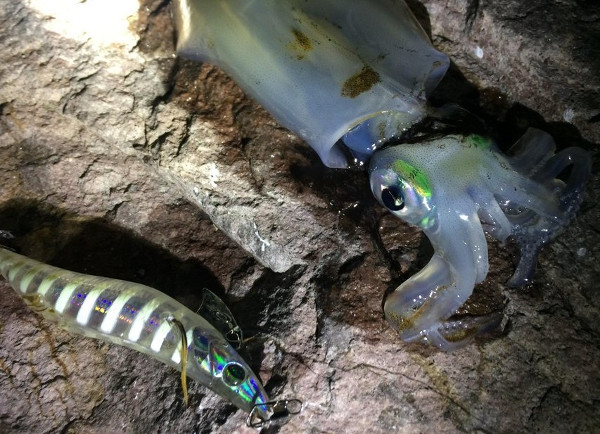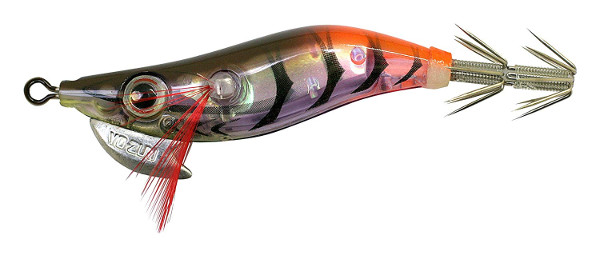Squid fishing (or squiding) is a fun way to switch things up from more traditional fishing. They’re one of my favourite types of seafood, and they make great bait too. Successfully targeting squid requires a slightly different technique than most other methods of fishing, but it’s not too hard. Let me teach you how to fish for squid, and what equipment you’ll need.

This post uses amazon affiliate links. I receive commission from any sales at no additional cost to yourself.
How to Catch Squid?
There’s a couple of different techniques that are effective to catch squid. On any given day, one technique might work better than the others. You just have to test them out and see what works in your area.
Cast and Retrieve
Using just the lure as terminal tackle (I go into detail on squid lures a bit further down.), cast it out and reel it back in. Work it like you would any other jig. bouncing it up and down, and adding a few pauses to vary the retrieve. Squid aren’t exactly picky, but the retrieve that works one day might not work the next.
Short steady jerks with a pause between each one while you’re reeling tend to work well. This imitates a fleeing shrimp that pauses and slowly sinks after flicking its tail. You can switch it up by making three sharp jerks followed by a pause as well.
Squid are quite fast, so don’t be afraid to reel it in quickly. Unless you’re really ripping the lure back, they shouldn’t have any difficulty catching it. They’re predators, so are often triggers by fast retrives, as this imitates a fleeing baitfish.
They’re also quite inquisitive and are likely to inspect a slowly retrieved lure as well. Switch it up, and see what works that day.
You can count down when you cast out to let it sink a little bit, or start reeling right away if you think they’re close to the surface.
Vertical Jigging
This method works well if you’re fishing off a boat, or a dock in deep water. Just drop the lure down and bounce it up and down to encourage a strike. You can tell when the lure hits the bottom when the line goes slack. You’ll generally have the most luck fishing up in the water coloumn off from the bottom
Fish a Drop Shot Rig
A drop shot rig can be useful for targeting deeper squid. Just attach the lure to a dropper loop a few feet above the sinker. You can cast this out and either let it sit or retrieve it. If you retrieve it, it’s helpful to slowly bounce the rod up and down while reeling back to cover more of the water column.
You can also effectively vertical jig with a drop shot rig. This can be a better choice than vertical jigging with just the lure if you need it to get deeper, or if there’s some current.
Float and Lure Rig
These are curious little creatures your targeting, and it isn’t always necessary to have an active retrieve. You can allow a jig to hang under a float, and squid in the area will check it out. It’s easy to adjust depth this way, and you only need a float big enough to support the jig.
The float will bob up and down when you have a bite just like a bobber would if a fish was on the line.
The Fight
Smaller species of squid don’t put up much of a fight, but you do have to be mindful of how you reel them in. The larger ones can rip the jig out of themselves.
Since squid jigs don’t use traditional hooks, it’s important to keep even steady pressure on your line while reeling in. It’s also important not to reel in to quickly or aggressively. Squid bodies are quite squishy, so you could easily rip the jig out of the squid.
To add to this, squid typically fight by “jetting” away. This feels like a pulsation on the rod line. They can actually rip the jig out of themselves if they’re jetting strong enough. To prevent this from happening, make sure the drag on your reel isn’t set too high.
What Equipment Do I Need for Squid Fishing?

Your standard light spinning rod will work great for targeting most types of squid. If you have a mackerel or trout spinning rod, that will work just fine.
What you do need is a squid jig. These are lures that have a few rows of barbs rather than the hooks used to target most fish species. These barbs get caught in the squid’s tentacles and are how you “hook” the squid. The Yo-Zuri Squid Jig (Amazon Link) is a high-quality lure that is also decently priced. If you’re looking for top quality, this is the lure you want.
This pack of Shrimp Squid Jigs 10PCS (Amazon Link) is great value for the number of jigs you get. They’re not as high quality as the To-Zuri jig but still work in most situations.
Whenever I’m fishing any type of jig I prefer to use braided line. This is because it has no stretch, and allows you to feel any bumps or subtle strikes on the lure easier. Mono and flouro lines will also work though, using braided line is just my personal preference for this type of fishing.
The line can be fairly light, 6 pound test works well as they don’t fight really hard. The lighter line also makes casting easier.
Landing Your Catch
If you just pull the squid out of the water with the jig, you’ll likely lose your catch. Tentacles, ink, and that beak of theirs make landing them by hand a bit tricky as well.
A net makes things much easier. Gently bring the net under the squid when it’s alongside the boat or dock. It’s worthwhile to bounce the net a few times with the squid in it. This can encourage the feisty cephalopod to discharge much of its ink before you land it. Even though this can lessen the amount of ink, still expect to get squirt (with both water and ink actually) if you’re fishing squid.
Removing the “hook”
Removing the jig from the squid is quite easy since it’s their tentacles that are hooked, not their mouth. These little hooks also don’t have any barbs, so they’re not really stuck in the flesh that much. Simply pull the jig away in the opposite direction the hooks are facing, and it’ll come right out.
Killing the Squid
Squid meat keeps much better if you kill them right away. This keeps them from getting stressed out, which can ruin the meat. It’s also more humane than letting them slowly die in a bucket.
The easiest way to kill a squid is to severe its nervous system right behind it’s brain. You can do this by sticking your figured behind the head and snapping it, or by firmly hitting it right behind the head. You can also stab it between the eyes where it’s brain is to dispatch it quickly.
Catch and Release?
You may want to target these cephalopods just for the fun of it. Or maybe you’re catching alot of small squid and just want to keep the big ones. Either way, you can successfully practice catch and release.
Squid have a good chance of surviving if they’re released quickly (less than 30 seconds or so) after being caught. As with fish, their chance of survival also depends on how much damage the hook has done.
What Time of Year to Fish for Squid?
This varies based on where you are living.
In colder climates, squid spend most of their time offshore in deeper water but do come inshore at certain times of the year. The time of year varies based on your specific location. It’s worth checking out forums specific to your area or asking locals for information on good fishing locations.
I’m most familiar with fishing squid in the Maritimes. Squid start showing up in the Halifax harbour around July (sometimes as early as June, it varies alott year to year) and the fishing gets really good into August. From there the squid fishing in Nova Scotia declines as fall approaches.
Many tropical areas have squid species that inhabits the reef. These species are accessible to anglers for a larger portion of the year than their colder climate counterparts.
What’s the Best Time of Day for Squid Fishing?
Again, this depends on species. Some are active in the day, many are active at night. In the Maritimes, the late evening and throughout the night into early morning is the best time to catch squid.
Many anglers will have noticed the best time of day and year for squid fishing coincides with the best striped bass fishing as well. I have no doubt that if you find a good concentration of squid, there’s a good chance there’s a striper or two nearby. Squid do make effective striped bass bait by the way.
Where Do I Fish For Squid?
You can fish for squid right off the docks if you do so at the right time of year. In the Maritimes, squid will come close to shore and actually into harbours in the late summer. Squid can oftentimes be found alongside schools mackerel, as they’re both chasing baitfish.
If you’re fishing from a boat, the same techniques used to find sport fish can be used to find squid. They’ll associate with structure such as kelp, seagrass, seaweed, docks, and boulders.
Some squid species are more structure oriented than others. Certain squid species prefer open water, and aren’t as drawn to structure. Again, it depends on the specific species in your area.
They’ll also often be chasing baitfish. Feeding seabirds can be a great indication of where baitfish are.

Where I can find squid jigging in Halifax area during this season
Squid are a highly sought after target species in many parts of Australia as they make excellent bait and also taste great. They can be caught year round, however most areas have a seasonal influx of squid and a giveaway that there are squid being caught is the ink found on jetties, pontoons, rock walls and other structure, along with the explosion of squid pics across social media.